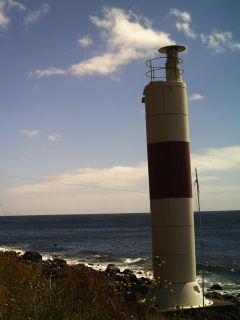
Copyright 2007 CE2WLB
Copyright 2007 CE2WLB
| HISTORIC On 8 March 1915, the Dresden put into Cumberland Bay on the Chilean island of Más a Tierra (today known as Robinson Crusoe Island) which was neutral territory. With 80 tons of coal remaining in her bunkers, out of ammunition for the main battery, lacking stores and supplies as well as parts for her worn-out engines, the ship ceased to be operational. Six days later, on 14 March, the British light cruisers HMS Glasgow and HMS Kent found the elusive German cruiser. After a few shots were fired, the Dresden ran up a white flag and sent Lieutenant Wilhelm Canaris to negotiate with the British. However, this was merely a ruse to buy time so the Dresden's crew could abandon ship and scuttle her. At 11:15 a.m. the Dresden slipped under the waves with her war ensign proudly flying in front of the position that today is located the “PUNTA SAN CARLOS LIGHTHOUSE”. Her crew of about 300 men was interned in Chile for the duration of the war, with about a third electing to remain and resettle in Chile at war's end. Lieutenant Wilhelm Canaris became famous during the Second World War as head of the German Military Intelligence Service, the Abwehr, and as member of the German Resistance. Epilogue Today the wreck, which lies in about 60 metres (200 ft) of water, is gaining popularity with recreational Scuba divers, and is occasionally used by the Chilean Navy for diver training. On 24 February 2006, Chilean and German divers found and recovered the Dresden's bell. The Republic of Chile presented the bell of SMS Dresden to the Museum of the German Armed Forces [Militärhistorisches Museum der Bundeswehr] at Dresden in November 2008, one hundred years after the commissioning of the cruiser. CS Forester's novel Brown on Resolution, and two subsequent movies, were inspired by the Dresden's escape and subsequent destruction. Forester's novel has a German warship escape the Battle of the Falkland Islands and make its way to an isolated Pacific Island, to effect repairs. |